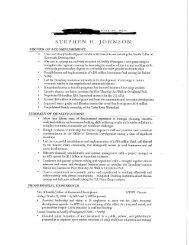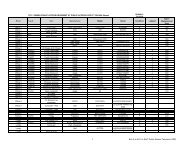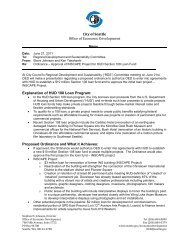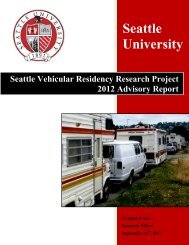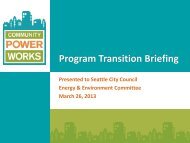2013 Water System Plan, Volume II - Seattle City Clerk's Office - City ...
2013 Water System Plan, Volume II - Seattle City Clerk's Office - City ...
2013 Water System Plan, Volume II - Seattle City Clerk's Office - City ...
Create successful ePaper yourself
Turn your PDF publications into a flip-book with our unique Google optimized e-Paper software.
Provide positive online indication of overflow.<br />
5.9.5 Mechanical Appurtenances and Equipment<br />
This section describes mechanical appurtenances and equipment for water storage facilities.<br />
5.9.5.1 Location<br />
To the extent practicable, mechanical appurtenances such as valves, pumps, and controls should<br />
be located in clusters. If applicable, they should be located in mechanical rooms or vaults for<br />
ease of maintenance and security.<br />
5.9.5.2 Penetrations to Storage Cells<br />
Penetrations for pipes, hatches, vents, and sensors into storage cells require special design<br />
considerations to preclude the intrusion of contaminants. The following are general<br />
considerations for mechanical appurtenances and equipment that penetrate storage cells:<br />
Materials and coatings of appurtenances should provide for high resistance to<br />
corrosion.<br />
Open ends of vents and overflow lines should be oriented downward and provided<br />
with 24-mesh, corrosion resistant screens.<br />
Wall and roof penetrations are welded on steel tanks and equipped with seep rings<br />
on concrete reservoirs.<br />
Valve stem penetrations must be sealed to prevent entry of contaminants.<br />
Materials used at penetrations must be selected to avoid creating galvanic currents<br />
between dissimilar metals.<br />
5.9.5.3 Vents<br />
Vents should be located at least 2 feet above finished grade or the 100-year flood<br />
elevation, whichever is greater.<br />
Vents must be sized to allow for adequate air intake during rapid drawdown of the<br />
water level such that the maximum pressure drop within the storage cell does not<br />
impose structural stresses. The acceptable maximum pressure drop is a function of<br />
structural materials and configuration of the storage cell. Acceptable maximum<br />
pressure drop must be established by a design engineer or manufacturer.<br />
5.9.5.4 Overflows<br />
The following are SPU standards for overflow pipes:<br />
1. Overflow pipes must be sized to accept flow rates equal or greater to the maximum<br />
inflow rate to the storage cell.<br />
2. Overflow pipes must terminate 1 to 2 feet but a minimum of two pipe diameters<br />
above grade to provide an air gap, and should be easily visible to O&M staff. Provide<br />
a minimum of two pipe diameters gap.<br />
5-56 SPU Design Standards and Guidelines



